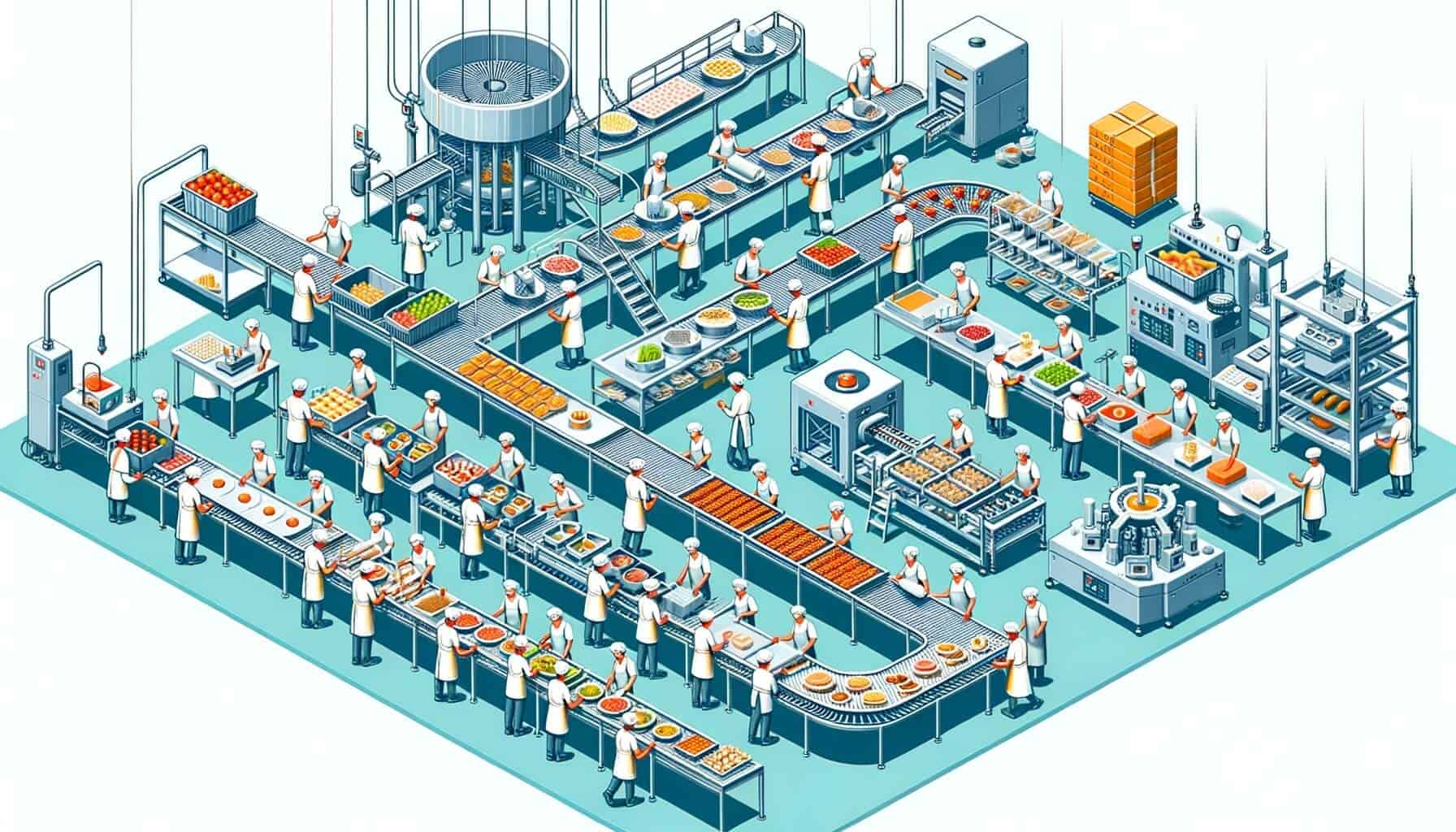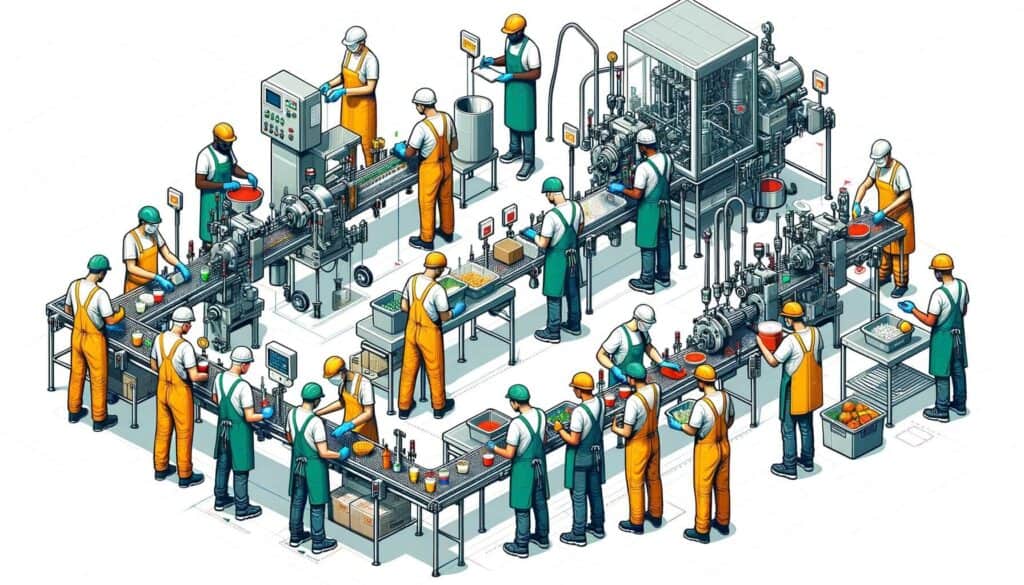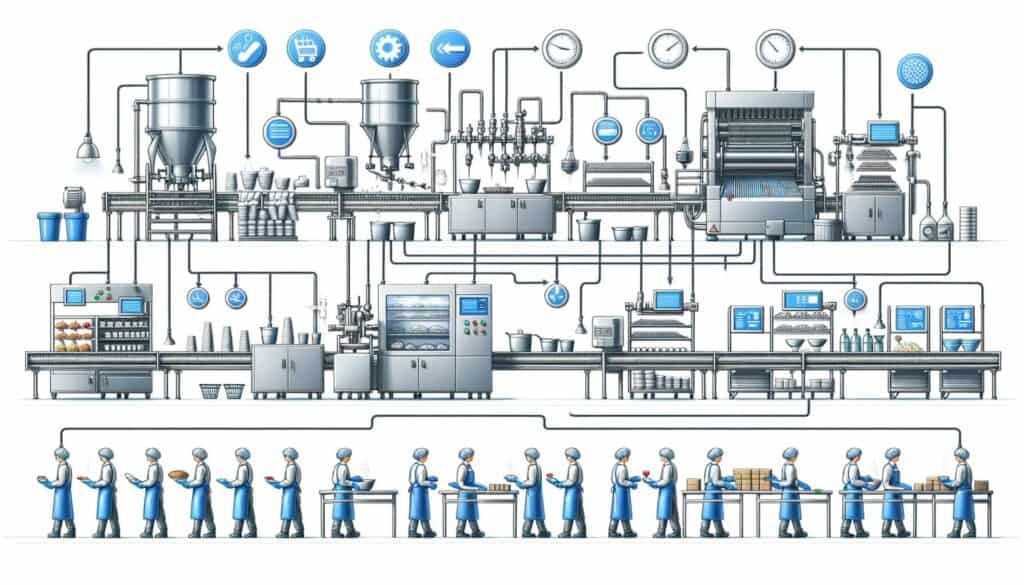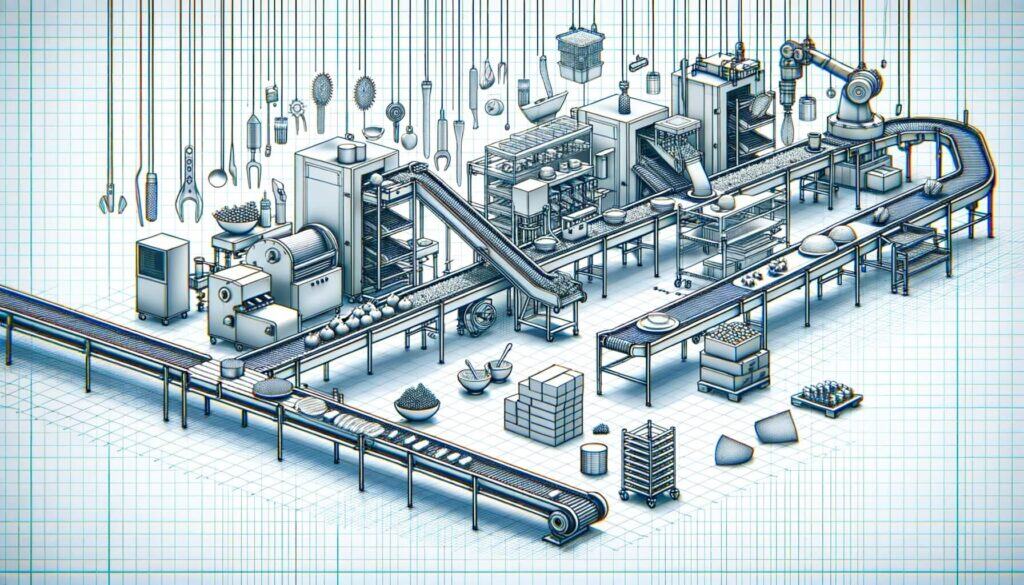
By Jermaine Thomas March 18, 2025
Large-scale events, such as conferences, weddings, and festivals, require meticulous planning and execution to ensure the satisfaction of attendees. One crucial aspect of these events is the food service, which often involves serving hundreds or even thousands of guests within a limited time frame. To achieve this, event organizers must establish an efficient food assembly line that can handle the high demand while maintaining quality and consistency.
An efficient food assembly line is essential for large-scale events for several reasons. Firstly, it allows for faster service, reducing waiting times for guests and ensuring a smooth flow of operations. This is particularly important in events where time is of the essence, such as conferences with scheduled sessions or weddings with a tight timeline.
Secondly, an efficient assembly line ensures consistency in food preparation, presentation, and portioning, guaranteeing that each guest receives the same quality and quantity of food. Lastly, a well-designed assembly line can help minimize waste and maximize productivity, leading to cost savings for event organizers.
Understanding the Basics: What is a Food Assembly Line?

A food assembly line is a systematic process of preparing and serving food in a sequential manner. It involves a series of stations or workstations, each responsible for a specific task in the food preparation process. The food moves along the assembly line, with each station adding or completing a particular component of the dish until it reaches the final station for plating or packaging.
The concept of the food assembly line was popularized by the fast-food industry, where speed and efficiency are paramount. However, it has since been adopted by various sectors, including large-scale event catering, to streamline operations and ensure consistent quality.
Planning and Designing an Efficient Food Assembly Line

Planning and designing an efficient food assembly line for large-scale events require careful consideration of various factors, including the event’s size, menu complexity, available space, and logistical constraints. Here are some key steps to guide you through the process:
1. Determine the menu: Start by finalizing the menu for the event. Consider the type of cuisine, the number of dishes, and any dietary restrictions or preferences. This will help you determine the number and type of stations required in the assembly line.
2. Analyze the guest count: Estimate the number of guests expected at the event. This will give you an idea of the volume of food that needs to be prepared and served, allowing you to allocate resources accordingly.
3. Assess the space: Evaluate the available space for setting up the assembly line. Consider factors such as the layout of the venue, the proximity to the kitchen or food preparation area, and any restrictions or regulations imposed by the event venue.
4. Determine the flow: Plan the flow of the assembly line, ensuring a logical sequence of stations that minimizes backtracking and congestion. Consider factors such as the order of food preparation, cooking times, and the need for any specialized equipment or tools.
5. Allocate resources: Determine the number of staff members required for each station based on the estimated guest count and the complexity of the menu. Ensure that each station has the necessary equipment, tools, and ingredients to perform their tasks efficiently.
Equipment and Tools Needed for a Successful Food Assembly Line

To establish a successful food assembly line for large-scale events, you need to equip each station with the necessary tools and equipment. Here are some essential items to consider:
1. Workstations: Each station should have a designated area with sufficient workspace, including countertops, cutting boards, and sinks for food preparation and cleaning.
2. Cooking equipment: Depending on the menu, you may need various cooking equipment such as stovetops, ovens, grills, fryers, or steamers. Ensure that each station has the appropriate equipment to execute their tasks efficiently.
3. Food processors and mixers: These tools are essential for tasks such as chopping, slicing, grating, and mixing ingredients. Invest in high-quality food processors and mixers that can handle the volume of food required for large-scale events.
4. Utensils and knives: Stock each station with an ample supply of utensils, including spatulas, tongs, ladles, and spoons. Additionally, provide a set of sharp knives for tasks that require precision cutting or carving.
5. Storage containers and trays: Use food-grade storage containers and trays to hold prepped ingredients, cooked food, and finished dishes. Ensure that these containers are easily stackable and have tight-fitting lids to maintain food freshness and prevent cross-contamination.
6. Heating and warming equipment: For events that require serving hot food, invest in heating and warming equipment such as chafing dishes, heat lamps, or hot holding cabinets. These tools will help maintain the temperature and quality of the food throughout the assembly line process.
Organizing the Workflow: Creating a Step-by-Step Process

To ensure a smooth and efficient flow of operations in a food assembly line, it is crucial to organize the workflow and create a step-by-step process. Here is a general framework to guide you:
1. Prepping and organizing place: Begin by prepping and organizing all the necessary ingredients and components for each dish. This includes washing, peeling, chopping, and portioning ingredients, as well as preparing any sauces, dressings, or garnishes.
2. Cooking and assembly: Once the ingredients are prepped, move on to the cooking and assembly stations. Cook the main components of each dish, such as proteins or grains, and assemble them with the prepped ingredients. Ensure that each station has the necessary tools and equipment to execute their tasks efficiently.
3. Quality control and plating: After the dishes are assembled, have a designated station for quality control. This station should ensure that each dish meets the desired standards in terms of taste, presentation, and portioning. Once approved, move on to the plating station, where the dishes are arranged attractively on plates or in containers.
4. Packaging and delivery: If the event requires take-out or delivery options, have a separate station for packaging the food. Use appropriate containers and labels to ensure that each package is properly sealed and clearly labeled with the dish name and any dietary information.
5. Cleaning and sanitation: Throughout the assembly line process, ensure that each station maintains cleanliness and follows proper sanitation practices. Have designated sinks or handwashing stations for staff members to wash their hands regularly. Additionally, establish a system for cleaning and sanitizing equipment, utensils, and workstations between tasks or at the end of the assembly line.
Ensuring Food Safety and Hygiene in the Assembly Line
Food safety and hygiene are of utmost importance in any food assembly line, especially for large-scale events where the risk of foodborne illnesses can have severe consequences. Here are some essential practices to ensure food safety and hygiene:
1. Staff training: Provide comprehensive training to all staff members involved in the assembly line process. This should include proper food handling techniques, personal hygiene practices, and knowledge of food safety regulations and guidelines.
2. Temperature control: Monitor and control the temperature of all perishable ingredients and cooked food throughout the assembly line process. Use refrigerators, freezers, and hot holding equipment to maintain the appropriate temperature range and prevent bacterial growth.
3. Cross-contamination prevention: Implement strict measures to prevent cross-contamination between raw and cooked ingredients. Use separate cutting boards, utensils, and storage containers for different types of food. Train staff members on proper cleaning and sanitizing procedures to avoid cross-contamination risks.
4. Hand hygiene: Emphasize the importance of proper hand hygiene among staff members. Ensure that each station has easy access to handwashing sinks or hand sanitizers. Encourage staff members to wash their hands regularly, especially after handling raw ingredients or using the restroom.
5. Allergen management: If the event involves serving guests with specific dietary restrictions or allergies, take extra precautions to prevent cross-contact with allergens. Clearly label dishes with allergen information and train staff members on proper handling and serving procedures for allergen-free options.
6. Regular inspections and audits: Conduct regular inspections and audits of the assembly line to ensure compliance with food safety and hygiene standards. This can include temperature checks, equipment maintenance, and staff observations. Address any issues promptly and provide additional training or resources as needed.
Staffing and Training for an Efficient Food Assembly Line
The success of a food assembly line for large-scale events heavily relies on the skills and efficiency of the staff members involved. Here are some key considerations for staffing and training:
1. Staff allocation: Determine the number of staff members required for each station based on the estimated guest count and the complexity of the menu. Ensure that each station has an adequate number of trained staff members to handle the volume of food and maintain efficiency.
2. Training programs: Develop comprehensive training programs for all staff members involved in the assembly line process. This should cover food safety and hygiene practices, proper handling and storage of ingredients, cooking techniques, portion control, and plating standards. Regularly update and reinforce training to ensure staff members are up to date with the latest practices.
3. Cross-training: Consider cross-training staff members to handle multiple stations within the assembly line. This provides flexibility and allows for smoother operations in case of staff shortages or unexpected changes in the workflow.
4. Communication and teamwork: Emphasize the importance of effective communication and teamwork among staff members. Encourage open lines of communication, where staff members can share feedback, suggestions, or concerns. Foster a positive and collaborative work environment to enhance productivity and morale.
5. Performance evaluation: Regularly evaluate the performance of staff members involved in the assembly line process. This can be done through observation, feedback from supervisors or peers, or customer feedback. Recognize and reward exceptional performance, and provide additional training or support to address any areas of improvement.
Maximizing Efficiency: Tips and Tricks for Streamlining Operations
To maximize efficiency in a food assembly line for large-scale events, consider implementing the following tips and tricks:
1. Standardize recipes and portion sizes: Develop standardized recipes and portion sizes for each dish to ensure consistency and minimize waste. Train staff members on portion control techniques to maintain uniformity throughout the assembly line process.
2. Use time-saving techniques: Identify tasks that can be done in advance to save time during the event. This can include prepping ingredients, marinating proteins, or pre-cooking certain components. However, ensure that these techniques do not compromise the quality or freshness of the food.
3. Optimize station layout: Arrange the stations in a logical sequence that minimizes backtracking and congestion. Consider the flow of ingredients and the order of food preparation to create an efficient workflow. Additionally, ensure that each station has easy access to necessary equipment, tools, and ingredients to avoid unnecessary delays.
4. Implement technology solutions: Explore technology solutions, such as kitchen display systems or order management software, to streamline operations and improve communication between stations. These tools can help track orders, monitor cooking times, and reduce errors or miscommunication.
5. Foster a culture of continuous improvement: Encourage staff members to identify areas for improvement and suggest innovative ideas to enhance efficiency. Regularly review and evaluate the assembly line process, seeking feedback from staff members and event attendees. Implement changes or adjustments based on these insights to continually optimize operations.
Troubleshooting Common Challenges in Food Assembly Lines
Despite careful planning and preparation, challenges may arise in a food assembly line for large-scale events. Here are some common challenges and strategies to overcome them:
1. Congestion and bottlenecks: If the assembly line becomes congested or experiences bottlenecks, consider redistributing staff members or adjusting the workflow to alleviate the issue. Monitor the flow of food and staff movement to identify areas of congestion and implement solutions accordingly.
2. Staff shortages: In case of unexpected staff shortages, have a contingency plan in place. Cross-train staff members to handle multiple stations or consider hiring temporary staff to fill the gaps. Ensure that all staff members are aware of their roles and responsibilities in such situations.
3. Equipment malfunctions: Equipment malfunctions can disrupt the assembly line process and cause delays. Regularly maintain and service all equipment to minimize the risk of breakdowns. Have backup equipment available in case of emergencies and train staff members on basic troubleshooting techniques.
4. Menu changes or substitutions: If there are last-minute menu changes or substitutions, communicate them effectively to all staff members involved. Ensure that each station has the necessary ingredients and instructions to execute the changes seamlessly. Maintain clear communication channels to address any questions or concerns from staff members.
5. Guest complaints or feedback: Address guest complaints or feedback promptly and professionally. Train staff members on effective customer service techniques and empower them to resolve issues on the spot whenever possible. Use feedback as an opportunity for improvement and implement necessary changes to prevent similar issues in the future.
FAQs
Q1. How can I estimate the number of staff members required for a food assembly line at a large-scale event?
A1. Estimating the number of staff members required depends on factors such as the expected number of attendees, the complexity of the menu, and the desired service speed. A general rule of thumb is to allocate one staff member for every 20-30 guests.
Q2. How can I ensure food safety during the assembly line process?
A2. Ensuring food safety involves proper handling, storage, and preparation of ingredients, as well as maintaining cleanliness and hygiene. This includes staff training, regular inspections, and compliance with food safety regulations.
Q3. What are some common challenges in food assembly lines, and how can they be addressed?
A3. Common challenges include bottlenecks, equipment malfunctions, staffing issues, and quality control. These challenges can be addressed through proper planning, regular maintenance, training programs, and quality control measures.
Q4. How can I increase the efficiency of a food assembly line?
A4. Increasing efficiency can be achieved through pre-assembly preparation, batch processing, just-in-time inventory, and continuous improvement. Regular evaluation and feedback from staff members and guests are also essential for identifying areas for improvement.
Conclusion
Establishing an efficient food assembly line for large-scale events is crucial for ensuring guest satisfaction, minimizing waiting times, and maximizing productivity.
By understanding the basics of a food assembly line, planning and designing the workflow, providing the necessary equipment and tools, and prioritizing food safety and hygiene, event organizers can streamline operations and deliver a memorable dining experience.
With proper staffing, training, and continuous improvement efforts, challenges can be overcome, and the assembly line can operate smoothly, even in the face of unexpected circumstances. By implementing the tips and tricks outlined in this article, event organizers can confidently execute a successful food assembly line for any large-scale event.